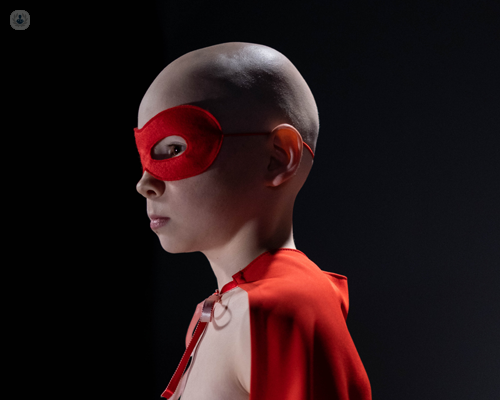Paediatric alopecia
Dr Eleojo Achimugu - Aesthetic medicine
Created on: 08-23-2022
Updated on: 12-14-2023
Edited by: Lauren Dempsey
What is paediatric alopecia?
Alopecia is the medical term for hair loss. If a child experiences hair loss before the age of 10, then they are considered to have paediatric alopecia. There are a variety of reasons why hair can fall out. It affects all races and genders.

What is a common age for children to get alopecia?
Hair loss can occur at any age. Alopecia can begin during childhood, adolescence, or adulthood. Studies have shown that paediatric-onset alopecia areata is more common in girls yet is often more severe in boys.
What are the types of alopecia in kids?
Whilst alopecia is another term for hair loss, alopecia areata is a specific condition of the immune system. The body attacks the hair follicles which results in hair loss. It is not contagious and seems to be caused by a combination of various genetic and environmental factors.
There are three major types of alopecia areata:
- Alopecia areata (patchy): Round hairless patches on the scalp that are smooth.
- Alopecia totalis: Complete hair loss on the scalp, about five per cent of cases.
- Alopecia universalis: Complete loss of body hair, happens in less than five per cent of cases.
How do I know if my child has alopecia?
These are common symptoms of alopecia areata in children:
- sudden hair loss
- round or oval hairless patches on the scalp
- smooth surface
Alopecia areata does not cause redness or scaling on the scalp. It can also affect the nails, causing pits on the surface, in up to half of all paediatric cases.
What diseases are associated with hair loss?
Various conditions cause paediatric hair loss. These include:
- Trichotillomania: Loss of hair due to hair pulling or plucking.
- Tinea capitis: A fungal infection that is contagious. It is commonly referred to as ringworm of the scalp.
- Telogen effluvium: Hair loss caused by an interruption of the normal hair growth cycle. Hair stops growing and can shed.
What causes alopecia in children?
Depending on the type of hair loss, there are a variety of reasons why a child might experience hair loss, including:
- an underlying illness
- autoimmune diseases
- nutrient deficiency
- underactive thyroid
Non-medical causes of alopecia include baby hair loss in the first few months of life or not being gentle with the hair; brushing it and pulling it too aggressively.
How is paediatric alopecia diagnosed?
In most cases, a GP will be able to determine the cause of a child’s hair loss based on the appearance of the areas of hair loss. If a diagnosis is inconclusive, your child may be referred to a dermatologist. The dermatologist might perform a trichoscopy, a technique that evaluates and diagnoses hair and scalp diseases.
How is paediatric alopecia treated?
Hair will grow back in most (non-scarring) cases and often a ‘wait and see’ approach is the most suitable option for young children. Sometimes, treatment will help to speed up regrowth. The most suitable treatment depends on the patient's age and medical history, as well as the extent and duration of the hair loss.
Common treatments include:
- topical steroids
- corticosteroid injection
- other topical therapies, like minoxidil
- immunotherapy
- Janus kinase (JAK) inhibitor (a type of drug to relieve joint pain and swelling)
In extreme cases, perhaps your child may need to see a hair transplant surgeon who is a paediatric alopecia specialist.
Is paediatric alopecia permanent? What is the prognosis?
Most causes of paediatric alopecia are non-scarring, meaning the follicle is not destroyed and the hair will grow back. Although hair loss can affect a child’s quality of life, usually recovery time will take less than a year and resolve itself without treatment.
If hair loss happens in childhood, it will likely be a reoccurring problem in life.
